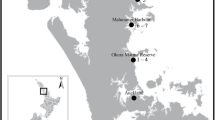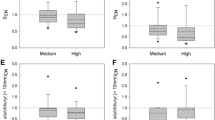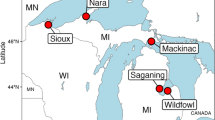Abstract
Degradation of aquatic ecosystems from nutrient pollution is a global issue, and quantifying nutrient removal in coastal ecosystems is a topic of interest for coastal managers worldwide. Analysing relationships between natural nitrogen removal processes, such as denitrification, and environmental variables from an ecological (rather than biogeochemical) perspective may help to identify and predict biogeochemically important habitat patches (hot spots). However, in situ measurements of denitrification that are coupled with ecosystem variables are rare. In this study, we analysed a dataset encompassing 18 estuaries, broad environmental gradients, and two methods of measuring denitrification (denitrification enzyme activity (DEA) and in situ N2 flux quantification) to better understand natural estuarine nitrogen removal processes and to rationalise methods. Generally poor relationships between denitrification measures and environmental variables suggest strong context dependency, with different activation or limiting reactants affecting denitrification rates differentially in space and time. This research illustrates how biogeochemically important habitat patches may develop and demonstrates that single-method studies have the potential to miss hot spots or hot moments of nitrogen removal. A two-method approach that integrates both long-term (DEA) and short-term (in situ N2 flux) conditions is more likely to lead to the identification of biogeochemically important habitat patches. A better understanding of natural nitrogen removal processes in estuaries will clarify assimilative capacity questions and feed into eutrophication mitigation management efforts in these highly valued freshwater–coastal interface areas.


Similar content being viewed by others
References
Aller RC. 1988. Benthic fauna and biogeochemical processes in marine sediments: The role of burrow structures. Blackburn TH, Sorensen J editors. Nitrogen Cycling in Coastal Marine Environments. Chichester: John Wiley & Sons, p301–338.
Anderson MJ, Gorley RN, Clarke KR. 2008. PERMANOVA+ for PRIMER: Guide to Software and Statistical Methods Plymouth, UK: PRIMER-E.
Bartoli M, Castaldelli G, Nizzoli D, Viaroli P. 2012. Benthic primary production and bacterial denitrification in a Mediterranean eutrophic coastal lagoon. Journal of Experimental Marine Biology and Ecology 438:41–51.
Berg S, Rysgaard S, Funch P, Sejr M. 2001. Effects of bioturbation on solutes and solids in marine sediments. Aquatic Microbial Ecology 26:81–94.
Bernhardt ES, Blaszczak JR, Ficken CD, Fork ML, Kaiser KE, Seybold EC. 2017. Control Points in Ecosystems: Moving Beyond the Hot Spot Hot Moment Concept. Ecosystems 20:665–682.
Bonaglia S, Nascimento FJA, Bartoli M, Klawonn I, Brüchert V. 2014. Meiofauna increases bacterial denitrification in marine sediments. Nat Commun 5.
Bowen JL, Babbin AR, Kearns PJ, Ward BB. 2014. Connecting the dots: linking nitrogen cycle gene expression to nitrogen fluxes in marine sediment mesocosms. Frontiers in Microbiology 5:429.
Brandes JA, Devol AH, Deutsch C. 2007. New Developments in the Marine Nitrogen Cycle. Chemical Reviews 107:577–589.
Brin LD, Giblin AE, Rich JJ. 2014. Environmental controls of anammox and denitrification in southern New England estuarine and shelf sediments. Limnology and Oceanography 59:851–860.
Caffrey J, Kemp WM. 1990. Nitrogen cycling in sediments with estuarine populations of Potamogeton perfoliatus and Zostera marina. Marine Ecology Progress Series 66:147–160.
Caffrey JM, Sloth NP, Kaspar HF, Blackburn TH. 1993. Effect of organic loading on nitrification and denitrification in a marine sediment microcosm. FEMS Microbiology Ecology 12:159–167.
Cook PLM, Revill AT, Butler ECV, Eyre BD. 2004. Carbon and nitrogen cycling on intertidal mudflats of a temperate Australian estuary. II. Nitrogen Cycling. Marine Ecology Progress Series 280:39–54.
Cornwell JC, Kemp WM, Kana TM. 1999. Denitrification in coastal ecosystems: methods, environmental controls, and ecosystem level controls, a review. Aquatic Ecology 33:41–54.
Decleyre H, Heylen K, Sabbe K, Tytgat B, Deforce D, Van Nieuwerburgh F, Van Colen C, Willems A. 2015. A doubling of microphytobenthos biomass coincides with a tenfold increase in denitrifier and total bacterial abundances in intertidal sediments of a temperate estuary. PLoS One 10: e0126583.
Douglas EJ, Pilditch CA, Hines LV, Kraan C, Thrush SF. 2016. In situ soft sediment nutrient enrichment: A unified approach to eutrophication field experiments. Marine Pollution Bulletin 111:287–294.
Douglas EJ, Pilditch CA, Kraan C, Schipper LA, Lohrer AM, Thrush SF. 2017. Macrofaunal functional diversity provides resilience to nutrient enrichment in coastal sediments. Ecosystems 20:1324–1336.
Dudley B, Jones-Todd C. 2018. New Zealand Coastal Water Quality Assessment Update. Christchurch: Prepared for Ministry for the Environment by NIWA. Client report No: 2018096CH.
Eyre BD, Rysgaard S, Dalsgaard T, Christensen PB. 2002. Comparison of isotope pairing and N2: Ar methods for measuring sediment denitrification - Assumptions, modifications, and implications. Estuaries 25:1077–1087.
Eyre BD, Ferguson AJP, Webb A, Maher D, Oakes JM. 2011a. Denitrification, N-fixation and nitrogen and phosphorus fluxes in different benthic habitats and their contribution to the nitrogen and phosphorus budgets of a shallow oligotrophic sub-tropical coastal system (southern Moreton Bay, Australia). Biogeochemistry 102:111–133.
Eyre BD, Maher D, Oakes JM, Erler DV, Glasby TM. 2011b. Differences in benthic metabolism, nutrient fluxes, and denitrification in Caulerpa taxifolia communities compared to uninvaded bare sediment and seagrass (Zostera capricorni) habitats. Limnology and Oceanography 56:1737–1750.
Eyre BD, Maher DT, Squire P. 2013. Quantity and quality of organic matter (detritus) drives N2 effluxes (net denitrification) across seasons, benthic habitats and estuaries. Global Biogeochemical Cycles 27:1083–1095.
Glud RN, Forster S, Huettel M. 1996. Influence of radial pressure gradients on solute exchange in stirred benthic chambers. Marine Ecology Progress Series 141:303–311.
Gongol C, Savage C. 2016. Spatial variation in rates of benthic denitrification and environmental controls in four New Zealand estuaries. Marine Ecology Progress Series 556:59–77.
Groffman PM, Altabet MA, Böhlke JK, Butterbach-Bahl K, David MB, Firestone MK, Giblin AE, Kana TM, Nielsen LP, Voytek MA. 2006. Methods for measuring denitrification: Diverse approaches to a difficult problem. Ecological Applications 16:2091–2122.
Groffman PM, Butterbach-Bahl K, Fulweiler RW, Gold AJ, Morse JL, Stander EK, Tague C, Tonitto C, Vidon P. 2009. Challenges to incorporating spatially and temporally explicit phenomena (hotspots and hot moments) in denitrification models. Biogeochemistry 93:49–77.
Groffman PM, Holland EA, Myrold DD, Robertson GP, Zou X. 1999. Denitrification. Robertson G, Bledsoe C, Coleman D, Sollins P editors. Standard soil methods for long term ecological research. Cary, NC: Oxford University Press, p272–288.
Hellemann D, Tallberg P, Bartl I, Voss M, Hietanen S. 2017. Denitrification in an oligotrophic estuary: a delayed sink for riverine nitrate. Marine Ecology Progress Series 583:63–80.
Henriksen K, Rasmussen MB, Jensen A. 1983. Effect of bioturbation on microbial nitrogen transformations in the sediment and fluxes of ammonium and nitrate to the overlaying water. Ecological Bulletins: 193–205.
Hillman JR, O'Meara TA, Lohrer AM, Thrush SF. 2021. Influence of restored mussel reefs on denitrification in marine sediments. Journal of Sea Research 175: 102099.
Howarth RW, Marino R. 2006. Nitrogen as the limiting nutrient for eutrophication in coastal marine ecosystems: Evolving views over three decades. Limnology and Oceanography 51:364–376.
Huettel M, Gust G. 1992. Solute release mechanisms from confined sediment cores in stirred benthic chambers and flume flows. Marine Ecology Progress Series 82:187–197.
Huettel M, Roy H, Precht E, Ehrenhauss S. 2003. Hydrodynamical impact on biogeochemical processes in aquatic sediments. Hydrobiologia 494:231–236.
Jones HFE, Pilditch CA, Bruesewitz DA, Lohrer AM. 2011. Sedimentary environment influences the effect of an infaunal suspension feeding bivalve on estuarine ecosystem function. PLoS One 6: e27065.
Kana TM, Darkangelo C, Hunt MD, Oldham JB, Bennett GE, Cornwell JC. 1994. Membrane inlet mass-spectrometer for rapid high-precision determination of N2, O2, and Ar in environmental water samples. Analytical Chemistry 66:4166–4170.
Kana TM, Sullivan MB, Cornwell JC, Groszkowski KM. 1998. Denitrification in estuarine sediments determined by membrane inlet mass spectrometry. Limnology and Oceanography 43:334–339.
Karlson K, Bonsdorff E, Rosenberg R. 2007. The impact of benthic macrofauna for nutrient fluxes from Baltic Sea sediments. Ambio 36:161–167.
Kennish MJ, Townsend AR. 2007. Nutrient Enrichment and Estuarine Eutrophication. Ecological Applications 17:S1–S2.
Kieskamp WM, Lohse L, Epping E, Helder W. 1991. Seasonal variation in denitrification rates and nitrous oxide fluxes in intertidal sediments of the western Wadden Sea. Marine Ecology Progress Series 72:145–151.
Knowles R. 1982. Denitrification. Microbiological Reviews 46:43–70.
Kristensen E, Jensen MH, Aller RC. 1991. Direct measurement of dissolved inorganic nitrogen exchange and denitrification in individual polychaete (Nereis-virens) burrows. Journal of Marine Research 49:355–377.
Kulkarni MV, Groffman PM, Yavitt JB, Goodale CL. 2015. Complex controls of denitrification at ecosystem, landscape and regional scales in northern hardwood forests. Ecological Modelling 298:39–52.
Lohrer AM, Thrush SF, Gibbs MM. 2004. Bioturbators enhance ecosystem function through complex biogeochemical interactions. Nature 431:1092–1095.
Lohrer AM, Stephenson F, Douglas EJ, Townsend M. 2020. Mapping the estuarine ecosystem service of pollutant removal using empirically validated boosted regression tree models. Ecological Applications 30: e02105.
Lunstrum A, McGlathery K, Smyth A. 2017. Oyster (Crassostrea virginica) Aquaculture Shifts Sediment Nitrogen Processes toward Mineralization over Denitrification. Estuaries and Coasts.
Martin K, Parsons LL, Murray RE, Smith MS. 1988. Dynamics of soil denitrifier populations: Relationships between enzyme activity, most-probable-number counts, and actual N gas loss. Applied and Environmental Microbiology 54:2711–2716.
McClain ME, Boyer EW, Dent CL, Gergel SE, Grimm NB, Groffman PM, Hart SC, Harvey JW, Johnston CA, Mayorga E, McDowell WH, Pinay G. 2003. Biogeochemical Hot Spots and Hot Moments at the Interface of Terrestrial and Aquatic Ecosystems. Ecosystems 6:301–312.
Newell RIE, Cornwell JC, Owens MS. 2002. Influence of simulated bivalve biodeposition and microphytobenthos on sediment nitrogen dynamics: A laboratory study. Limnology and Oceanography 47:1367–1379.
Newell SE, McCarthy MJ, Gardner WS, Fulweiler RW. 2016. Sediment Nitrogen Fixation: a Call for Re-evaluating Coastal N Budgets. Estuaries and Coasts: 1–13.
Nixon SW. 1995. Coastal marine eutrophication: A definition, social causes, and future concerns. Ophelia 41:199–219.
O’Meara TA, Hewitt JE, Thrush SF, Douglas EJ, Lohrer AM. 2020. Denitrification and the role of macrofauna across estuarine gradients in nutrient and sediment loading. Estuaries and Coasts 43:1394–1405.
Parsons LL, Smith MS, Murray RE. 1991. Soil Denitrification Dynamics: Spatial and Temporal Variations of Enzyme Activity, Populations, and Nitrogen Gas Loss. Soil Science Society of America Journal 55:90–95.
Pelegri SP, Nielsen LP, Blackburn TH. 1994. Denitrification in estuarine sediment stimulated by the irrigation activity of the amphipod Corophium volutator. Marine Ecology Progress Series 105:285–290.
Plew DR, Zeldis JR, Dudley BD, Whitehead AL, Stevens LM, Robertson BM, Robertson BP. 2020. Assessing the Eutrophic Susceptibility of New Zealand Estuaries. Estuaries and Coasts 43:2015–2033.
Risgaard-Petersen N, Rysgaard S, Nielsen LP, Revsbech NP. 1994. Diurnal-variation of denitrification and nitrification in sediments colonized by benthic microphytes. Limnology and Oceanography 39:573–579.
Russell DG, Warry FY, Cook PLM. 2016. The balance between nitrogen fixation and denitrification on vegetated and non-vegetated intertidal sediments. Limnology and Oceanography 61:2058–2075.
Rysgaard S, Christensen PB, Nielsen LP. 1995. Seasonal variation in nitrification and denitrification in estuarine sediment colonized by benthic microalgae and bioturbating infauna. Marine Ecology Progress Series 126:111–121.
Schipper LA, Cooper AB, Harfoot CG, Dyck WJ. 1993. Regulators of denitrification in an organic riparian soil. Soil Biology & Biochemistry 25:925–933.
Seitzinger SP. 1988. Denitrification in freshwater and coastal marine ecosystems: Ecological and geochemical significance. Limnology and Oceanography 33:702–724.
Seitzinger S, Harrison JA, Böhlke JK, Bouwman AF, Lowrance R, Peterson B, Tobias C, Van Drecht G. 2006. Denitrification across landscapes and waterscapes: A synthesis. Ecological Applications 16:2064–2090.
Smith MS, Parsons LL. 1985. Persistence of denitrifying enzyme activity in dried soils. Applied and Environmental Microbiology 49:316–320.
Smith MS, Tiedje JM. 1979. Phases of denitrification following oxygen depletion in soil. Soil Biology & Biochemistry 11:261–267.
Smith CJ, Dong LF, Wilson J, Stott A, Osborn AM, Nedwell DB. 2015. Seasonal variation in denitrification and dissimilatory nitrate reduction to ammonia process rates and corresponding key functional genes along an estuarine nitrate gradient. Frontiers in Microbiology 6:542.
Smyth AR, Thompson SP, Siporin KN, Gardner WS, McCarthy MJ, Piehler MF. 2013. Assessing nitrogen dynamics throughout the estuarine landscape. Estuaries and Coasts 36:44–55.
Stief P. 2013. Stimulation of microbial nitrogen cycling in aquatic ecosystems by benthic macrofauna: Mechanisms and environmental implications. Biogeosciences Discussions 10:11785–11824.
Sundback K, Miles A. 2000. Balance between denitrification and microalgal incorporation of nitrogen in microtidal sediments, NE Kattegat. Aquatic Microbial Ecology 22:291–300.
Thrush SF, Hewitt JE, Gibbs M, Lundquist C, Norkko A. 2006. Functional role of large organisms in intertidal communities: Community effects and ecosystem function. Ecosystems 9:1029–1040.
Thrush SF, Hewitt JE, Kraan C, Lohrer AM, Pilditch CA, Douglas E. 2017. Changes in the location of biodiversity–ecosystem function hot spots across the seafloor landscape with increasing sediment nutrient loading. Proceedings of the Royal Society B: Biological Sciences 284:1852.
Tiedje JM, Simkins S, Groffman PM. 1989. Perspectives on measurement of denitrification in the field including recommended protocols for acetylene based methods. Plant and Soil 115:261–284.
Vieillard AM, Thrush SF. 2021. Ecogeochemistry and Denitrification in Non-eutrophic Coastal Sediments. Estuaries and Coasts.
Vieillard AM, Newell SE, Thrush SF. 2020. Recovering From Bias: A Call for Further Study of Underrepresented Tropical and Low-Nutrient Estuaries. Journal of Geophysical Research: Biogeosciences 125: e2020JG005766.
Volkenborn N, Meile C, Polerecky L, Pilditch CA, Norkko A, Norkko J, Hewitt JE, Thrush SF, Wethey DS, Woodin SA. 2012. Intermittent bioirrigation and oxygen dynamics in permeable sediments: An experimental and modeling study of three tellinid bivalves. Journal of Marine Research 70:794–823.
Ward BB. 2013. How Nitrogen is Lost. Science 341:352–353.
Webb AP, Eyre BD. 2004. Effect of natural populations of burrowing thalassinidean shrimp on sediment irrigation, benthic metabolism, nutrient fluxes and denitrification. Marine Ecology Progress Series 268:205–220.
Zarnoch CB, Hoellein TJ, Furman BT, Peterson BJ. 2017. Eelgrass meadows, Zostera marina (L.), facilitate the ecosystem service of nitrogen removal during simulated nutrient pulses in Shinnecock Bay, New York, USA. Marine Pollution Bulletin 124:376–387.
Acknowledgements
We thank the many people who contributed to the extensive field and lab work carried out for each of the individual studies included here, especially Kit Squires, Grady Petersen, Teri O’Meara, and Rebecca Gladstone-Gallagher. We thank Judi Hewitt for advice on statistical analyses and draft revision. This study was funded by NIWA (Coasts and Oceans Research Programme 5 SCI 2020/21), and the Sustainable Seas National Science Challenge (New Zealand Ministry of Business Innovation and Employment Contract No. C01X1515; Projects 2.1.3 and 4.2.1).
Author information
Authors and Affiliations
Corresponding author
Ethics declarations
Conflict of interest
The authors declare no competing interests.
Additional information
Author contributions ED and AM designed the study; ED, HN, MT, CP, and AM conducted field work and sampling, ED conducted laboratory analyses; ED, JG, and FS conducted statistical analyses; ED wrote the manuscript; and all authors contributed substantially to revisions.
Supplementary Information
Below is the link to the electronic supplementary material.
Rights and permissions
About this article
Cite this article
Douglas, E.J., Gammal, J., Needham, H.R. et al. Combining Techniques to Conceptualise Denitrification Hot Spots and Hot Moments in Estuaries. Ecosystems 25, 1670–1681 (2022). https://doi.org/10.1007/s10021-021-00732-7
Received:
Accepted:
Published:
Issue Date:
DOI: https://doi.org/10.1007/s10021-021-00732-7




